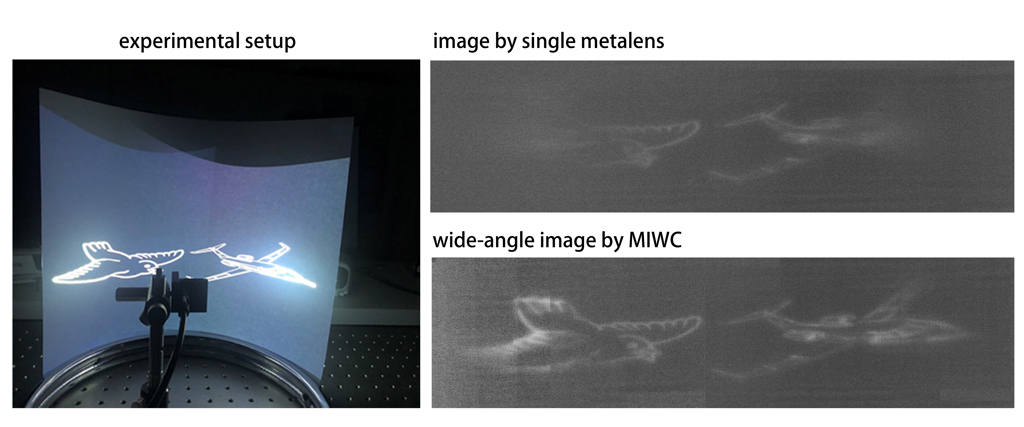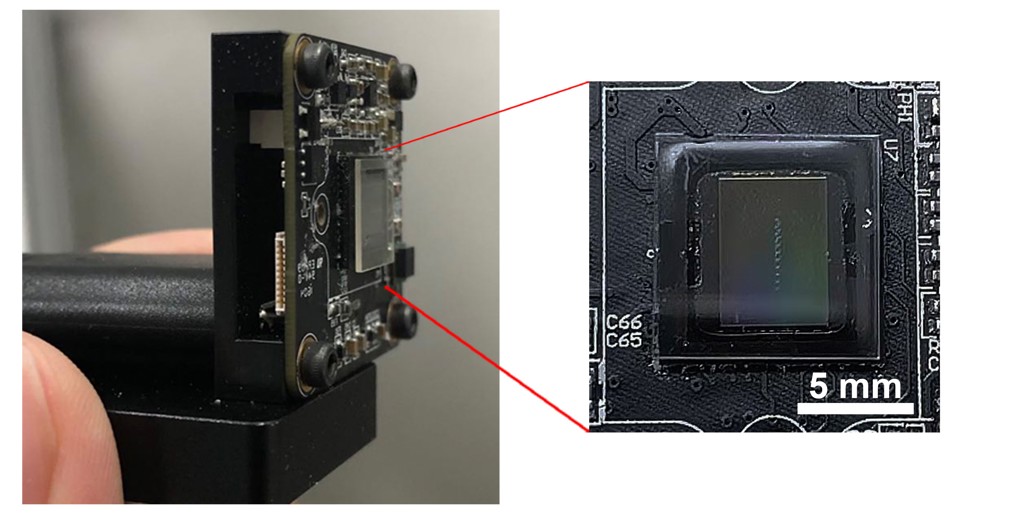Researchers create miniature wide-angle camera with flat metalenses
About Optica
14 April 2022
Researchers create miniature wide-angle camera with flat metalenses
New design enables high-quality wide-angle cameras that can possibly fit into smartphones
WASHINGTON — Researchers have designed a new compact camera that acquires wide-angle images of high-quality using an array of metalenses — flat nanopatterned surfaces used to manipulate light. By eliminating the bulky and heavy lenses typically required for this type of imaging, the new approach could enable wide-angle cameras to be incorporated into smartphones and portable imaging devices for vehicles such as cars or drones.
Tao Li and colleagues from Nanjing University in China report their new ultrathin camera in Optica, Optica Publishing Group’s journal for high-impact research. The new camera, which is just 0.3 centimeters thick, can produce clear images of a scene with a viewing angle of more than 120 degrees.

Caption: Researchers designed a new compact camera that acquires high-quality wide-angle images using an array of metalenses. Their new planar camera (MIWC) produced clearer images of pictures projected across a curved screen compared to a camera based on a single traditional metalens.
Image Credit: Tao Li, Nanjing University
Wide-angle imaging is useful for capturing large amounts of information that can create stunning, high-quality images. For machine vision applications such as autonomous driving and drone-based surveillance, wide-angle imaging can enhance performance and safety, for example by revealing an obstacle you couldn’t otherwise see while backing up in a vehicle.
“To create an extremely compact wide-angle camera, we used an array of metalenses that each capture certain parts of the wide-angle scene,” said Li. “The images are then stitched together to create a wide-angle image without any degradation in image quality.”
Miniaturizing the wide-angle lens
Wide-angle imaging is usually accomplished with a fish-eye compound lens or other type of multilayer lens. Although researchers have previously tried to use metalenses to create wide-angle cameras, they tend to suffer from poor image quality or other drawbacks.
In the new work, the researchers used an array of metalenses that are each carefully designed to focus a different range of illumination angles. This allows each lens to clearly image part of a wide-angle object or scene. The clearest parts of each image can then be computationally stitched together to create the final image.
“Thanks to the flexible design of the metasurfaces, the focusing and imaging performance of each lens can be optimized independently,” said Li. “This gives rise to a high quality final wide-angle image after a stitching process. What’s more, the array can be manufactured using just one layer of material, which helps keep cost down.”
Seeing more with flat lenses
To demonstrate the new approach, the researchers used nanofabrication to create a metalens array and mounted it directly to a CMOS sensor, creating a planar camera that measured about 1 cm × 1 cm × 0.3 cm. They then used this camera to image a wide-angle scene created by using two projectors to illuminate a curved screen surrounding the camera at a distance of 15 cm.

Caption: The researchers fabricated a metalens array (enlarged on the right) and mounted it directly to a CMOS sensor. This created a planar camera that measured about 1 cm × 1 cm × 0.3 cm.
Image Credit: Tao Li, Nanjing University
They compared their new planar camera with one based on a single traditional metalens while imaging the words “Nanjing University” projected across the curved screen. The planar camera produced an image that showed every letter clearly and had a viewing angle larger than 120°, more than three times larger than that of the camera based on a traditional metalens.
The researchers note that the planar camera demonstrated in this research used individual metalenses just 0.3 millimeters in diameter. They plan to enlarge these to about 1 to 5 millimeters to increase the camera’s imaging quality. After optimization, the array could be mass produced to reduce the cost of each device.
Paper: J. Chen, X. Ye, S. Gao, Y. Chen, Y. Zhao, C. Huang, K. Qiu, S. Zhu, T. Li, “Planar wide-angle-imaging camera enabled by metalens array,” Optica, 9, 431-437 (2022) https://doi.org/10.1364/OPTICA.446063
About Optica Publishing Group
Optica Publishing Group is a division of the society, Optica, Advancing Optics and Photonics Worldwide. It publishes the largest collection of peer-reviewed and most-cited content in optics and photonics, including 18 prestigious journals, the society’s flagship member magazine, and papers and videos from more than 835 conferences. With over 400,000 journal articles, conference papers and videos to search, discover and access, our publications portfolio represents the full range of research in the field from around the globe.
About Optica
Optica is an open-access journal dedicated to the rapid dissemination of high-impact peer-reviewed research across the entire spectrum of optics and photonics. Published monthly by Optica Publishing Group, the Journal provides a forum for pioneering research to be swiftly accessed by the international community, whether that research is theoretical or experimental, fundamental or applied. Optica maintains a distinguished editorial board of more than 60 associate editors from around the world and is overseen by Editor-in-Chief Prem Kumar, Northwestern University, USA. For more information, visit Optica.
Media Contact
